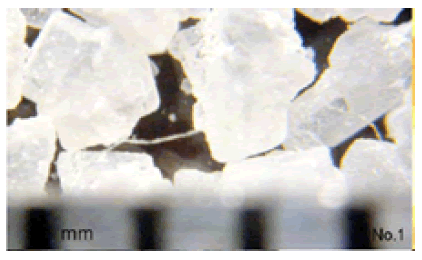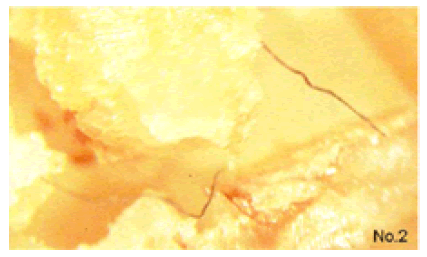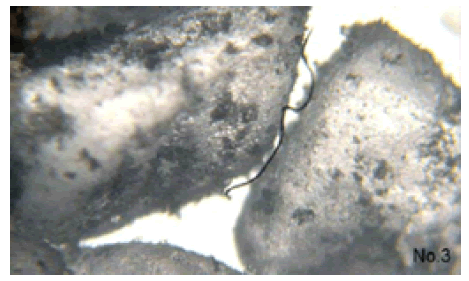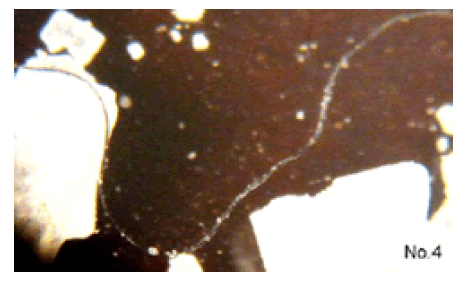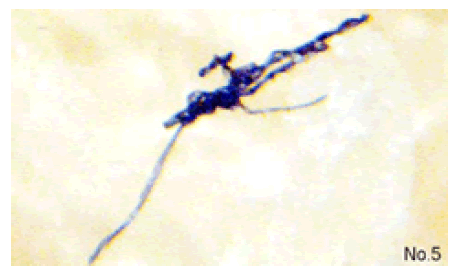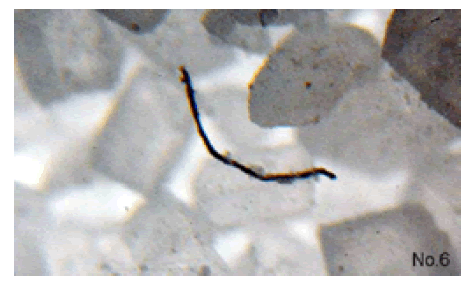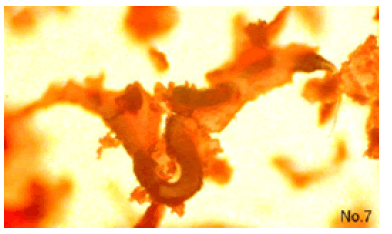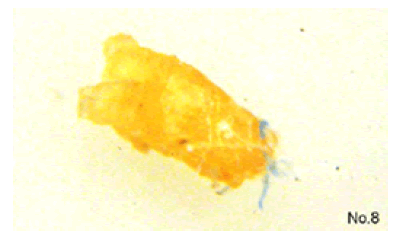Research Article - Clinical Investigation (2023) Volume 13, Issue 4
The Physical Source of Morgellons Disease
- Corresponding Author:
- Wilson McCord
Wilson McCord Science and Technology, Manhattan, New York
E-mail: willsscience@gmail.com
Received: 29-March-2023, Manuscript No. fmci-23-93341; Editor assigned: 30-March-2023, Pre QC No. fmci-23-93341 (PQ); Reviewed: 04-April-2023, QC No. fmci-23-93341 (Q); Revised: 08-April-2023, Manuscript No. fmci-23-93341 (R); Published: 30-April -2023; DOI: 10.37532/2041-6792. 2023.13(4).431-437
Abstract
Morgellons Disease is a condition where micro-filaments are found coming from, embedded in or under the skin of patients and is complicated by accompanying infections throughout the body. Evidence is provided here for the source of Morgellons Disease and suggests that Morgellons Disease is caused by physical contaminants.
Keywords
Morgellons Disease • Dermatitis • Multi-colored filaments • Industrial micro-plastics • Physical Contaminants
Introduction
Morgellons Disease is identified and described by physicians as a condition that is painful and irritating, where multi-colored filaments are found embedded in, found under and or protruding from the dermis layers (skin) of patients. It is complicated by multiple infections found throughout the body. With very little literature on the subject of Morgellons Disease it is still very poorly understood. It is still not clear if the symptoms that are identified with Morgellons Disease have been isolated as solely responsible for this pathology. And, it has not been clearly documented whether the symptoms described to Morgellons Disease are associated with this one dermopathy and not in combination with other diseases or illnesses. Most importantly, in the past, the source of this condition has not been discovered by previous researchers. This seems to be where much of the confusion lies in describing Morgellons Disease. A proposal is made here to identify the physical source and etiology of Morgellons Disease as one of physical contaminants that are accompanied by additional acute infections.
Background
Over 14,000 families are reported to have the symptoms and suffering caused by Morgellons Disease. Symptoms that have been reported by patients with Morgellons Disease are described but not limited to: skin rashes, sores, irritation under the skin that causes itching, crawling sensations under the skin, filaments and threads imbedded in the skin layers or protruding from the top layer of dermis, extreme fatigue and tiredness, difficulty in concentrating, the loss of short term memory and depression. Morgellons Disease severely impairs an individual’s health and their quality of life. This contemporary disease was named after a disease in the 1600s, in France, where symptoms of dark hairs were found growing out of the skin of children. These symptoms may have been caused by the heavy fabrics worn and damp conditions of that era and can possibly be compared with the dark hairs that grow while wearing a plaster cast. The recent description of Morgellons Disease does not have the same description and its symptoms began to appear after 2002. As Morgellons Disease surfaced it was thought to be a behavioural and Central Nervous System (CNS) disorder by the Centers for Disease Control and Prevention (CDC) and patients with its symptoms were diagnosed with psychopathologies. The physical symptoms of Morgellons Disease were thought to be delusions that caused physical manifestations appearing as parasites in the dermal layers of patients. At the same time it was also thought to be an immune deficiency state, a chronic inflammatory process and a possible chronic infectious process. Only recently has a clearer description of Morgellons Disease come from researchers.
Borrelia infections began to be associated with the appearance of filaments under the skin in 2005. And, in 2009 researchers concluded that Morgellons was a multisystemic illness that appears to cause various skin phenomena [1]. In the United States and Australia Morgellons Disease specimens taken from patients have included a number of Borrelia spirochete species. In 2016 Middelveen and Stricker reported that Morgellons Disease is a filamentous Borrelial dermatitis and classified it as a dermopathy. But a previous study done by the Center for Disease Control and Prevention (CDC) in 2012, concluded that the Disease was not caused by a pathogen [2].
Borrelia infections are caused by tick borne bacterial infections that produce spirochetes. Lyme Disease (LD) is one of these infections. Borrelia burgdorferi spirochetes have been found in most but not all Morgellons patients and Borrelia garinii, B. miyamotoi and B. hermsii species have also been found in Morgellons patients [3].
After numerous physical tests, these researchers discovered that many of the filaments found in patients are composed of keratin and collagen. Some consider the number of tick borne diseases equal to the number of Morgellons Disease cases that have been diagnosed throughout the World. And, Morgellons Disease is thought to be a spirochetal infection by some researchers because its symptoms often resemble those of Lyme Disease.
Recent World maps of Morgellons Disease cases, on the World Wide Web, seem to show that the cases of Morgellons Disease are centered in the industrialized Western World culture: The United States and Canada, Western Europe, Australia and South Africa. Japan, parts of Indonesia, Malaysia and Papua New Guinea, which seem to be isolated territories, are shown to have a large number of cases but can possibly be linked to the Western territories through the industrialization and distribution of food products.
Materials and Methods
In January of 2019 I found micro-filament contaminants in the sugar supply. These filaments are almost impossible to see looking at the sugar crystals with the naked eye but can be seen at low resolutions under a stereo microscope. Later, observations of processed foods led to the discovery of micro-filaments in products like: cereals, tortilla chips, bread, frozen pizza and in coffee pods for coffee machines as well as sea salt and processed salts. Because sugar is used to sweeten most food products, and salts are used to flavor most foods, it has been concluded here that this is how much of the contaminant has spread to other food products. It was the observation of some processed foods that gave clues to the contamination of the salts. Filaments that make up the inner layers of the coffee pods along with separate micro-filaments were found to be contributing to the contamination of coffees.
Microscopy and Observations
After the collection of the specimens, observations were made and micrographs were taken in August of 2019. Strainers were used to sift the sugar crystals and allowed for the collection of filaments. Regardless of the use of strainers, any sample taken of the foods examined revealed the presence of these filaments throughout the products (Figure 1 and Figure 2).
Figure 2: Cereal with Filament
A Southern Precision, Shimadzu Kalnew 1840-3 (Tokyo, Japan) Microscope was used to observe and take micrographs of micro-filaments and the food sources in which they were found. Measurements were taken using a printed micrograph slide where 1 division = 0.1mm, with additional divisions between. The filaments were found to be 3.3 ± 0.05um (microns) thick and 400um (microns) long. Capillaries in the human body are 5 to 10 micrometers wide (0.001mm= 1um (micrometer): 1 micron). Many of these filaments are pointed at one or both ends and are small enough to travel through all of the arteries and veins of the human body once entering the circulatory system. The smallest capillaries could potentially allow these filaments to reach the dermis (skin) layer (Figure 3-5).
The filaments seem to have an electro-static characteristic that allows them to stick to metals, plastics and other materials like glass; they also seem to have a static attraction to foods like coffee. It is possible that this characteristic allows the fiber to travel easily once in the blood stream. These filaments are well hidden in crystals of sugar and salt and some of them seem to have a hooking characteristic that resemble a filo virus shape. The filaments do not seem to be biological but may cause bacterial infection once introduced into the human body. In two investigations of sugar, insect abdomens were discovered. Some filaments taken from food specimens seemed to have bacteria attached (Figure 6). There were filaments found that were filled with liquid (Figure 7, 8) and therefore; bodily fluids could fill the filaments and make passage more difficult and lodging in the micro capillaries more possible.
Result
Morgellons Disease creates terrible suffering in humans. It is proposed here that Morgellons Disease is caused by multi-colored filaments that are industrial or bio-industrial products that contaminate numerous food sources in the United States and abroad, with sugar and salt being the main sources of contamination. All of the filaments found in examined food sources exactly resemble the colored filaments associated with, and found in, Morgellons Disease patients. Several insect abdomens were found in sugars, so the parasites and the filaments may be linked in the foods consumed in the Western and industrialized parts of the World.
The abnormal skin sensations associated in patients with Morgellons Disease prior to the appearance of lesions and the protruding of filaments have been documented at the CDC [2]. This reaction is the sensation of the filaments coursing through the body after food intake. These filaments are reaching the dermis layer after the system is over- run with the foreign bodies; the build-up in the system causes the filaments to leave the blood stream through the smallest capillaries and enter the skin, protrude and also become intertwined in the dermal layers during skin regeneration. The filaments probably interrupt skin healing which is propagated by patient scratching. But the lesions in true Morgellons Disease cases are not being contaminated with filaments from outside of the skin after scratching. In true Morgellons Disease cases; the micro-plastic filaments are coming from under the skin and are being ingested by the patients during food intake along with the insect body parts that cause Lyme Disease. This results in a buildup of these substances and the onset of other internal and external bacterial infections
While there have probably been patients with psychosomatic disorders examined along with patients who have classic symptoms that characterize Morgellons Disease, people with Morgellons Disease are not hallucinating this illness. These filaments are physical entities that are embedded in the skin, cause extreme pain, disfiguring discomfort and complicated infections. Some studies still suggest Morgellons Disease is a psychopathology [4]. But, the prescribing of antipsychotics for patients with true Morgellons Disease could be dangerous.
Making a number of diagnosis and observations in 2012 on the manifestations of Morgellons Disease, the Center for Disease Control and Prevention (CDC) has said there is a malfunctioning of follicular keratinocytes (hair follicle keratin cells) but this may be due to the interference of the micro-plastic filaments with the hair and skin in the dermis. The CDC also noted that there were plastic filaments found in the skin of Morgellons Disease patients that were floral in color and some of these were florescent. The filaments I observed fit this description and were thin long micro-plastic filaments that were either bright in color or clear, with the exception of a few black filaments (Figure 6). On observation it is clear that these filaments were manufactured in an industrial setting. Some researchers have described the filaments as having root-like growths, but this could be due to the passing of the filaments through the capillaries and exiting through the skin. Although I have not directly examined any specimens from the Morgellons Disease patients, images on the Morgellons Research Foundation website of imbedded filaments resemble exactly the filaments that were found in all of the products examined which includes the sugars and salts.
While some researchers claim that some of the filaments are made of keratin and collagen it is likely that these filaments have not been made in the human body. Through genetic engineering Escherichia coli, bacteria, yeasts, plants, silkworms and other animals have been used to produce spider silk proteins having different, simpler, characteristics from a spider [5]. So too, could it be possible to bioengineer and produce hair-like filaments of a biological nature as well as chemically produce plastic filaments with similar characteristics. More recently new methods have allowed tougher filaments to be produced, than those that are made in nature (i.e. spider silk), during biomimetic processing.
The contamination of the industrialized food supply with micro-plastics, such as the ones I have observed, may be a global problem that has only begun to be recognized by the science community. In a study commissioned by the World Wide Fund for Nature (WWF) researchers at the University of New Castle in Australia focused on the contamination of the Earth with micro-plastics that measured less than 1mm [6]. After examining fifty research papers the group found micro-plastic pollution in the sea; its surfaces and ice, the water column and deep sea floor, its arctic beaches; terrestrial and freshwater environments and in remote uninhabited islands throughout the World.
More importantly, they found that humans are ingesting almost 5 grams of these micro-plastics each week. Researchers at the Alfred Wegener Institute in Germany and the Swiss Institute for Snow and Avalanche Research found that micro-plastics were in ice cores taken from the Arctic [7]. This is a clear indication that micro-plastics have been polluting the Earth for a considerable length of time.
Discussion
The filaments I have found in food sources are suspected to either have been placed in the food as industrial bio-terrorism (industrial material used to contaminate the human body; to disrupt biological processes, cause illness or death) or, they originate at the industrial level of food production and can be found throughout the industrialized World in food manufacturing environments. The difference in the micro-plastics I have found, and what is quite troubling, is that these filaments are thin, long and fit well in the veins and arteries. They are small enough to travel into and exit the capillaries; which means they are capable of penetrating most other tissues and organs in the human body, including the brain. And this may be contributing to the loss of short-term memory found in some Morgellons Disease patients [1]. My observations of these micro-filaments revealed that these are indeed plastics (which have not eroded or changed over time). If the biomimetic filaments, that are tougher than those found in nature, have found their way into the food supply, like the plastics, these contaminants would not be easily broken down by the human body. Morgellons does not seem to be a natural Borrelia spirochete infection. But, it may be complicated by the accompaniment of Borrelia bacteria also present in contaminated foods. The CDC has said it is an unexplained skin disorder and that most of the filaments are cotton fibers. But the research of Middelveen and Stricker (2016) found that these filaments were not cellulose found in cotton, linen, plant based fibers or chitin . Neither plant nor fungal based, it was found that they contained keratin, which makes up bone, horn and other hard tissues and it is possible that some of these have been biomimetically produced or are byproducts of the industrialized livestock industry. Millions of people may have these filaments in their systems. And it may not become noticeable, or a problem that is addressed, until they are examined for other health conditions.
The insect abdomens I found in the sugar could have been those of the Deer tick (Ixodes scapularis) which causes Lyme Disease and could be the reason for the discovery of Lyme disease in many Morgellons Disease patients. Only tests that can identify the insect abdomens can determine their species and if the Borrelia bacteria spirochetes are present. But, it has led to the conclusion that Lyme disease in Morgellons Disease patients could come from the food products.
These insect body parts could be placed in a food sourse as bio- terrorism or simply, are in the food source because of the natural agricultural settings in which the food is gathered to be processed. Morgellons patients who have Lyme disease have two diseases, a cross infection that is only noticed after being examined for symptoms of one or the other. This reveals Morgellons Disease to be a syndrome made up of complicated physical and biological contaminants as well as bacterial infections. Truly, Morgellons Disease is an environmental problem which originates where we process our foods.
Conclusions
The Morgellons Research Foundation has found that antibiotics have been among the most successful treatments for the bacterial infections or protozoa found in patients with Morgellons Disease. Many of these infections, in patients that do not have Lyme Disease, are probably secondary infections caused by the filaments. Babesiosis found in conjunction with a Borrelia bacterial infection can be caused by the same tick that carries Lyme Disease. Patients who contract pneumonia, Borrelia or Babesia species infections are given antibiotics to resolve those symptoms. Filamentous contaminants that are ingested by Morgellons Disease patients may cause infections to arise in the lungs as well as throughout the body’s organs. In particular, the electro-static characteristic of these foreign bodies may increase the potential for bacteria to gather and infection to occur. Other possible treatments for physicians to consider might be surgical procedures to remove the filaments found in and under the skin with the hope that the skin will heal after surgery. Any parasite or bacterial infection can be met with antibiotics for known infectious symptoms as well as identified diseases that are secondary disorders caused by the filaments interruption and in-growth in the body's system. Exercise may help with blood circulation causing the foreign bodies to be removed during the body’s waste process. Finding the source in an individual’s diet, having a solid diagnosis and relieving any pain or infection will help control depression in these patients. Changes in diet can eliminate the intake of these filaments. This can help the Morgellons patient on to a course of recovery
References
- Harvey WT, Bransfield RC, Mercer DE, et al. Morgellons disease, illuminating an undefined illness: a case series. J Med Case Rep. 3;8243(2009).
- Pearson ML, Selby JV, Katz KA, et al. Clinical, Epidemiologic, Histopathologic and Molecular Features of an Unexplained Dermopathy. PLoS One. Jan 25; 7(1):e29908(2012).
- Middelveen MJ, Stricker RB. Morgellons disease: a filamentous borrelial dermatitis. Int J Gen Med. 9:349-54(2016).
- Beuerlein KG, Balogh EA, Feldman SR. Morgellons disease etiology and therapeutic approach: a systematic review. Dermatol Online J. 27(8):1(2021).
- Heidebrecht A, Eisoldt L, Diehl J, et al. Biomimetic fibers made of recombinant spidroins with the same toughness as natural spider silk. Adv Mater. 13:2189-94(2015).
- Senathirajah K, Attwood S, Bhagwat G, et al. (2021) Estimation of the mass of microplastics ingested – A pivotal first step towards human health risk assessment. J Haz Mater. 404(Part B):124004(2021).
- Bergmann M, Mutzel S, Primpke S, et al. White and Wonderful? Microplastics prevail in snow from the Alps to the Arctic. Sci Adv. 5(8):eaax1157(2019).
